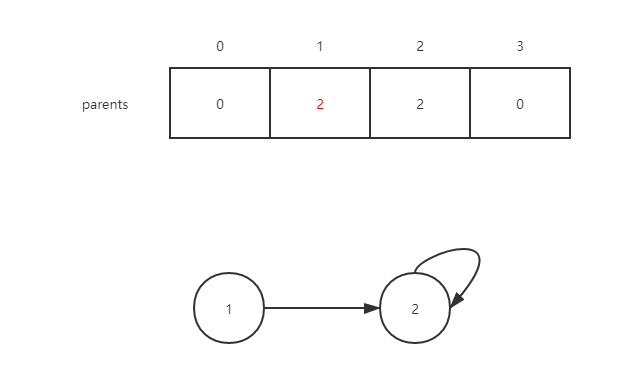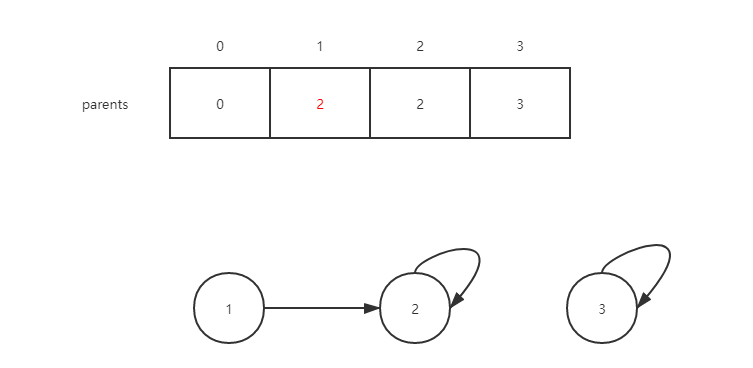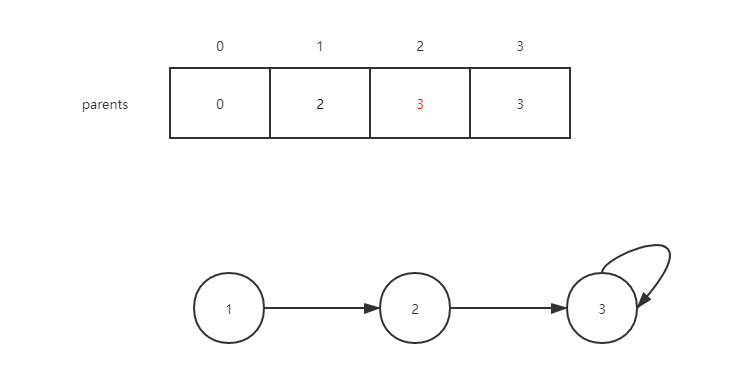题目:
In this problem, a tree is an undirected graph that is connected and has no cycles.
The given input is a graph that started as a tree with N nodes (with distinct values 1, 2, ..., N), with one additional edge added. The added edge has two different vertices chosen from 1 to N, and was not an edge that already existed.
The resulting graph is given as a 2D-array of edges. Each element of edges is a pair [u, v] with u < v, that represents an undirected edge connecting nodes u and v.
Return an edge that can be removed so that the resulting graph is a tree of N nodes. If there are multiple answers, return the answer that occurs last in the given 2D-array. The answer edge [u, v] should be in the same format, with u < v.
Example 1:
Input: [[1,2], [1,3], [2,3]] Output: [2,3] Explanation: The given undirected graph will be like this: 1 / 2 - 3
Example 2:
Input: [[1,2], [2,3], [3,4], [1,4], [1,5]]
Output: [1,4]
Explanation: The given undirected graph will be like this:
5 - 1 - 2
| |
4 - 3
分析:
给定一个边的序列来构建一个无向图,求出序列中第一条使得无向图成为有环无向图的边。
可以利用dfs来进行搜索,每新加入一条边,查看原来的无向图中是否存在这条边两个顶点间连通分量,如果有的话就会构成环。
dfs的时间复杂度为O(n^2),我们可以利用并查集的思想解决这道题。
以[1,2], [1,3], [2,3]为例。
我们新开辟一个数组用来保存节点间的关系,新加入边[1,2]时。

如果parents数组为0,则将对应索引的值初始化为自身,也就代表两个结点指向的是自己,利用并查集的思想,连通的节点之间所属同一集合。对两个结点进行查询,返回他们最终的父结点,如果两个结点最终的父结点相同,代表他们在同一个集合中,无向图加入这条边就有环了,如果没有的话,将这两个集合合并。

然后加入边[1,3],结果如下图

查找1和3的父结点,分别返回2,和3,他们不相同,将两个集合合并,也就是将2的父亲标记为3

最后加入边[2,3],我们通过上面的图可以发现2,3的父结点最终都是3,是相同的,证明他们在同一集合中,直接返回这条边即可。
在这里并查集可以进行一定的优化,例如合并时,可以将容量小的集合合并到大的集合中,这样修改结点关系的操作较小,而且每次搜索最终父结点时,可以在查询父结点时,同时修改其父结点的关系,减少下次查询消耗的时间。
程序:
C++
class Solution { public: vector<int> findRedundantConnection(vector<vector<int>>& edges) { vector<int> parents(edges.size()+1, 0); for(auto edge:edges){ int u = edge[0]; int v = edge[1]; if(!parents[u]) parents[u] = u; if(!parents[v]) parents[v] = v; int pu = find(u, parents); int pv = find(v, parents); if(pu == pv) return edge; parents[pu] = pv; } return {}; } private: int find(int node, vector<int> &parents){ while(node != parents[node]){ parents[node] = parents[parents[node]]; node = parents[node]; } return node; } };
Java
class Solution { public int[] findRedundantConnection(int[][] edges) { int[] parents = new int[edges.length+1]; for(int[] edge:edges){ int u = edge[0]; int v = edge[1]; if(parents[u] == 0) parents[u] = u; if(parents[v] == 0) parents[v] = v; int pu = find(u, parents); int pv = find(v, parents); if(pu == pv) return edge; parents[pu] = pv; } return null; } private int find(int node, int[] parents){ while(node != parents[node]){ parents[node] = parents[parents[node]]; node = parents[node]; } return node; } }